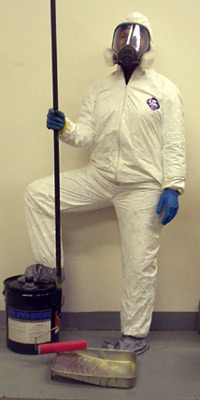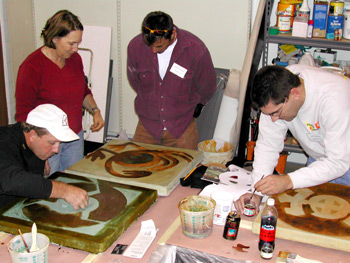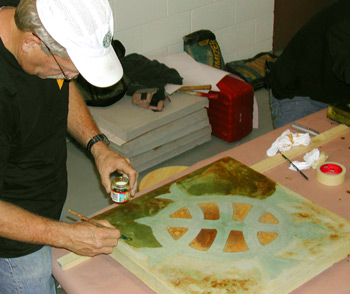 |
|||||||
| January 06, 2005
About Sealers and Waxes I am presently updating my books, so look for the new edition of the definitive Stainer’s Manual soon. I’m assembling the photos now and hope that it will be edited and ready to go to press in about a month. In the meantime, I want to bring you up-to-date on what we are currently using for sealers and waxes, since the Forum has been kept busy lately with questions on this topic. We used to feel that we should stay within brands, so if we were using Brand Y’s acid stain, we should use Brand Y’s sealer as well. We were forced to deviate from this policy when we needed a durable solvent-based sealer for heavily trafficked floors in public spaces. Our preferred stain maker, L.M. Scofield, does not manufacture a solvent-sealer due to the air quality laws in California, where their plant is located. So we tried Super Diamond Clear (xylene-based) by the Euclid Chemical Company and it worked well, but we think that xylene is the most obnoxious of the solvents to deal with and it often thickened up on us during the time we were rolling it on. We then switched to Gemseal by the Brickform Company, since it could be shipped to a local supplier it used lacquer thinner as a solvent. At present, our favorite solvent-based sealer is Elite Crete’s AUS-50, aliphatic urethane sealer. It uses naphtha as the solvent. (See www.elitecrete.com for a supplier in your area). All of these sealers “breathe,” as is necessary on new concrete and yet they are scratch-resistant and penetrating, so they darken the stains almost to their “wet” color. None of these solvents is fun to deal with, but we find naphtha a bit less noxious than the others. One reason may be that we bought full-face masks and plastic suits for the crew. We finally realized that a half-face mask was not doing the trick, since the solvents can enter the body through eyeballs and skin as well as lungs. Here is a photo of my assistant, Rae, in the fashion outfit which she calls her Bunny Suit. The paper-plastic suit is disposable and even has feet built into it. The second photo shows a shopping arcade in Santa Fe, where we used two coats of AUS-50 and then two coats of On an’ On.
It is true that solvent-sealers scratch less easily than water-based, but we still feel we should apply two coats of wax as a sacrifice layer. This is something the janitorial staff is used to dealing with, as opposed to closing the building for days to apply more solvent sealer, which is usually not feasible. We talked in a past newsletter about something called “plasticizer migration.” See newsletter issue 7 in the archives. You must warn your clients NEVER to apply any kind of flexible plastic to their floors—this includes duct tape, masking tape, inflatable mattresses, carpet-protection pads and so forth. When these items are removed they can pick up all four layers of wax and sealer and even some stain, because, in layman’s terms, plastic wants to bond to whatever plastic is placed next to it. You should also warn against the use of silicone dusting products (such as Endust) in daily maintenance, since a layer of silicone on the floor will repel the next coat of wax. Strong detergents, ammonia, bleach, and even hot scrub water will turn most waxes white or cloudy. It will save you hours of grief on the phone with ‘desperate housewives’, if you warn them in advance of these possible wax killers. Once we discovered that we did not have to stick with the same brand of stain and sealer, we felt free to experiment further. We met a very well-informed man who owns a janitorial supply store near our office. He showed us the entry to his showroom, which was coated with four or five coats of a sealer-wax hybrid called Sheen C-40. He gets loads of foot traffic in his store and I was impressed with how well it held up. Sheen C-40 is a water-based acrylic which serves as both sealer AND wax coat. It is semi-penetrating, so it appears to go further into the slab than most water-based sealers and it darkens the colors slightly (though not as much as a true solvent-sealer). A five-gallon bucket costs us about $90.00 (contractor’s price). What we really love is the reduced labor time. We used to have to wait four hours for each coat of Cementone Clear Sealer to cure. I would pay the crew to sit around or have coffee breaks for four hours so that they could get two coats on in a day. We then applied our wax coats the following day, since we wanted to be sure our sealer had cured.
We use two workers on the first coat, since someone needs to go around walls and round objects with a paint pad. This sealer is not applied with a lambswool applicator, but is mopped on with a rayon yarn mop. The sealer is put into a janitorial squeeze-bucket of Sheen and wrung out fairly well. The first coat will show some streaks from the mop, but subsequent coatings rectify this. It is hard to do nice edges with a mop and not get sealer on the walls, but when we have gone around the walls once or twice with a paint pad we are safe to stay back from the walls on subsequent coatings. The Sheen C-40 dries to a nice low gloss. It never gets the glassy look of On an’ On wax, and I am starting to feel that this is a distinct advantage. I recently had a very picky client who was distressed to see the oil from her dog’s foot-pads sitting on the surface of her pristine, glassy floor wax. This was only visible at certain angles and in certain light conditions. Pale sneaker-scuffs were also visible there. It may be most practical not to condition clients to such an incredibly perfect surface unless they are prepared to go to a “no shoe policy” in their home. The only thing we could suggest to this client, since she had tried repeatedly cleaning and re-waxing was that she maintain the floors with high-speed buffing. We rented one and showed her that it erased the areas which bothered her, without leaving visible buffer marks or reducing the super gloss to which she was so attached. Have YOU Reserved your spot for the Upcoming Artistic Design Techniques Seminar? My Advanced Acid Staining Techniques Seminar that we held in November was a great experience. Here are a few pictures of us working on individual mini-slabs. This seminar is an excellent way to learn how take your work to the artistic level. Attendance is filling up and only a few spaces are left. For more information please visit www.acidstainsecrets.com or call 505.246.9954. We hope to see YOU there!
Happy Staining! GG |
|||||||
|
|
|||||||




